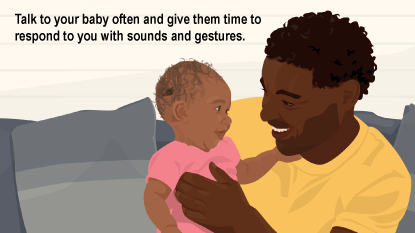To communicate means to share thoughts, ideas, and feelings. We communicate through sounds, words, facial expressions, and touch. At this age, your baby will start to enjoy the back and forth of sounds and expressions (such as smiling) between you.



You know your baby best. If your baby has signs that concern you, call your health care provider.

How do I know if my baby's communicating normally for their age? There is a wide range of normal development in babies. In general, by the end of the third month, a baby will:
Talk to your health care provider if you have questions or concerns about your baby's development.
Is my baby crying too much? Most babies have a fussy period about the same time every day, which usually begins in early evening. All babies cry and can be fussy, but some cry more than others. Most babies start to cry less when they're about 3–4 months old. Call your health care provider if your baby is crying for more than 3 hours at a time and this happens more than 3 times a day or if you are feeling overwhelmed by your baby's crying.